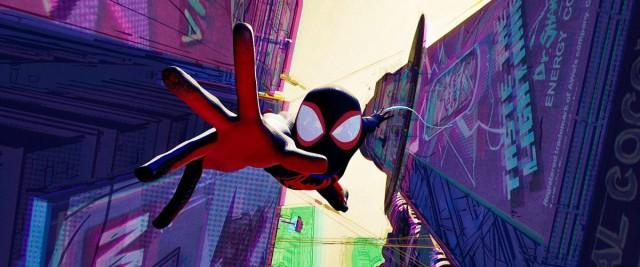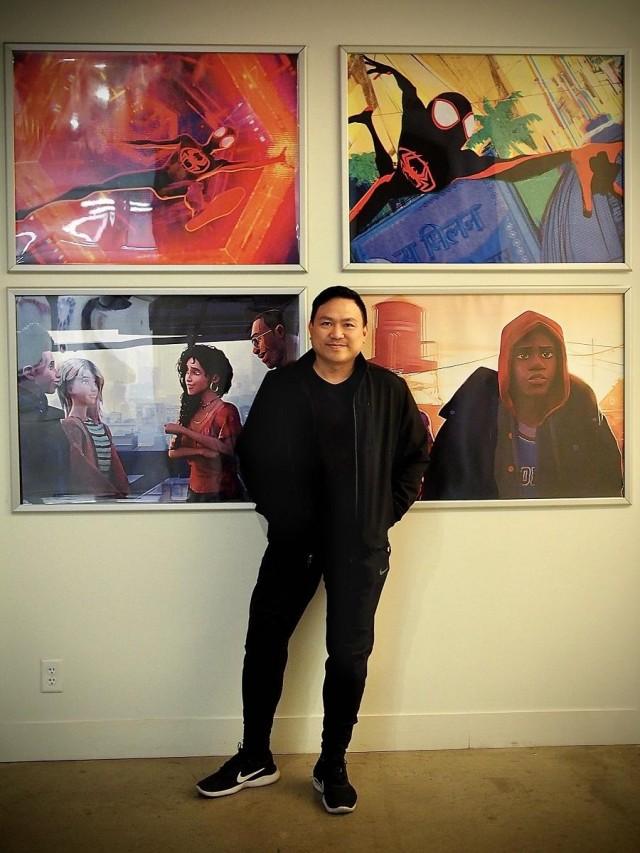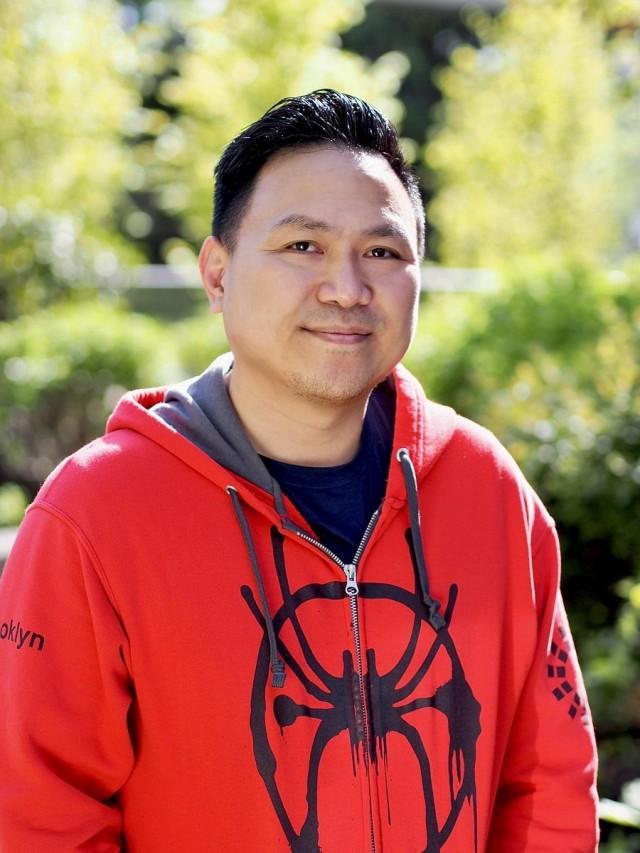Filipino-Canadian artist Ronald Samson talks about his work on 'Spider-Man: Across the Spider-Verse'

When you watch the latest upcoming animation, "Spider-Man: Across the Spider-Verse," you will be proud to know that the fight scene of Miles and the Spot at the beginning of the film was done no less by a Filipino.
Ronald Samson, a lighting and compositing artist from Manila but now based in Vancouver, Canada, worked on the popular franchise. Unknown to many, the University of Santo Tomas alum, also worked on such movies as "Spider-Verse," "Hotel T3," "Rango," and "Matrix."
"My little brother and myself always watched any animation we can absorb and promised each other that watching animation is for life," said the charming and humble Thomasian said.
We were able to talk by Zoom to Samson about his work on the movie which will be coming out in the Philippines on May 31. Below is our conversation with him.

Congratulations on your involvement with the "Spider-Man: Across the Spider-Verse" movie! Can you please tell us exactly what you do as a lighting and compositing artist?
It's definitely an honor and a pleasure to be part of this amazing movie, which is actually the second film in a trilogy. So, I think the easiest way to describe my job as a lighting and compositing artist is basically, we give the scene color and lighting, and ambiance to complement the story and the character performances. Basically, my job is the final stop. We combine the animation process, combine everything, and collect the different elements coming from the different departments, and hopefully, we can create images that can evoke an emotional reaction from the viewers.
Can you talk about the challenges of doing the scenes that you did, like the fight scene of Miles and the Spot at the beginning of the film?
I was definitely involved in some of those things, and they are challenging because some of the special effects that we did there have never been done before. So, a lot of the action scenes take a lot of time to make it look correct. Also, when you're doing an action scene sometimes it's hard to depict it and make sure that it will resonate with the audience, right? So, it has to be perfect and crisp in every aspect.
What scenes did you enjoy working on and why?
One of those is actually the Spot scenes, which is one of the new and exciting villains in the movie. Like I said, they were hard because he has unique powers, and you will see it in the movie. He has unique powers, effects you haven't seen in the past before, and it was fun to be part of that whole sequence.
Can you please tell us how you got involved in animation? Did you take up animation in college?
I have always loved animation, and since I was a kid, there was never a clear path growing up in the Philippines on how to be an animator. So basically, especially in computer graphics animation, it was a new thing in the '90s. So instead, I went to fine arts school in the University of Santo Tomas, and I was actually an art editor in The Varsitarian, which is the school paper of UST, just to keep my artistic juices flowing.
But in my senior year, there was a job fair at UST. It was luck, as well, that there's a US-based owned and operated company that came in, and they're called Imaginatia. I don't think they exist anymore. But I applied and a bunch of my friends applied, and luckily, I was one of the handful who got hired.
We did six months of training. We were using the most advanced computer software during that time. Eventually, they sent me to the US to work on some Hollywood movies. My wife and I met in The Varsitarian. She's the special reports editor. So that's where we had our love affair.

Please tell us more about your Philippine roots.
I was born in Santa Cruz, Manila, but grew up pretty much in Quezon City. But my mother and father were Bicolanos, so I learned a little bit of the dialect because I grew up in a Bicolano compound.
It's very common in the Philippines that we would have families in one compound. So, I picked it up although I didn't grow up in Bicol.
My spouse and I left for Singapore in 2006 to work, so I worked there first. And then eventually, we migrated to Vancouver, Canada in 2012 because the work was starting to migrate, as well, to Canada.
What inspired you to be an animator or an artist?
I always enjoyed animation, like Saturday morning cartoons in the Philippines, that's a big deal for me and my brothers. We would watch it. It was our bonding time. And we would be recreating some of the animation we would see and we promised each other that we're going to keep watching animation, cartoons, as long as we can.
As adults, we'll keep watching animation. And those were really memorable and fun times. So, we never stopped watching cartoons. And then eventually I decided. Since I know I'm pretty skilled with drawing and arts and stuff, I'm going to pursue animation.
Who are your animator influences or idols?
So actually, mainstream animation in the Philippines when we were watching it, we couldn't really name the main animators. They're normally just Hanna-Barbera, the Warner Brothers, and those names.
But when I went to college, I got into more animation with my friends who also loved anime. I totally loved anime. So, one of the biggest ones that I could think of would be Hayao Miyazaki. He's the one who did "Spirited Away," "Princess Mononoke."
I love Miyazaki because he doesn't just show great visuals. All his animation would have character and emotion and it draws in. It's really good storytelling.
How long have you been working in the studio and what was your first job in the studio?
I think I'm already in my eighth year with Sony, but I've been in the industry for at least 24 years. When I graduated, it was 24 years.
When I started animation, I was still an undergrad, so I wasn't done. So, it has been 24 years in the industry. But my first project in Sony was "Hotel Transylvania Part Two" as a lighting technical director.

What other films do you work on right now?
To date, I have worked on at least 14 films under Sony. And it's always a great experience, never a dull moment. So, some of those would be, of course, the first "Spider-Verse," "Into the Spider-Verse." I worked on "Hotel Transylvania," "Smurfs," "Angry Birds."
Recently, I worked on "The Sea Beast," which was actually nominated for the Oscars. Before Sony, I worked in "Star Wars Clone Wars." I did a bit of "Avengers" and "X-Men" and "Fast and the Furious," and "Rango."
What are your dream projects?
The Saturday morning cartoons that I was mentioning earlier are old traditional cartoons. I would love to see some of them re-imagined in computer graphics because we have more advanced computer technology now. I would like to see, for example, I don't know if you're familiar with "Inhumanoids," "Visionaries," and maybe the more popular one, "Thundercats." That would be amazing to see them on the big screen.
What would you advise aspiring Filipino artists who would like to work also in Hollywood like you?
I guess they just need to remember that we have a very colorful history and we have some natural talent in any arts, maybe in singing, dancing, or maybe visual arts. We excel in those things, right? So given that, you just need to keep working hard. And always pursue your dreams.
Then when there's an opportunity, grab it and don't let any failure keep you from pursuing what you want to do. I did animation because I wanted to do animation.
I kept hammering on it, doing it and trying it. And maybe last but not least, be open to criticism. Don't be offended when somebody gives you some critique of your work. Just keep working on it. Because good or bad advice, you will push your work to a higher level.
What do you think are your strengths as an artist?
I'm very flexible style-wise. Because I do different kinds of work.
Coming from fine arts, I can do different kinds of mediums, like mechanical drawing, sculpting, oil painting, and pencil sketching. I can do them. So, I think that's a very good skill to have, and it translates pretty well in computer graphics.
So in computer graphic animation, you have to be flexible, because you need to see different angles and lenses of the same thing and do a different twist to an art.
—MGP, GMA Integrated News




